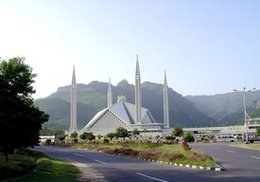Faisal Mosque
|
|

King Faisal Mosque (Shah Faisal Masjid شاه فیصل مسجد in Urdu) is one of the largest mosques in the world, located in Islamabad, the capital city of Pakistan. It is a well-known mosque in the Islamic world and is renowned for both its immense size and its architecture.
| Contents |
History
In 1976, construction began on the mosque, funded by the government of Saudi Arabia, costing over 130 million Saudi riyals. King Faisal of Saudi Arabia was instrumental in the funding, and it was thus dedicated to him after his assassination. It was completed in 1986, and used to house the International Islamic University. The small mausoleum of General Muhammad Zia-ul-Haq is located right outside of the mosque.
Design
The mosque has an area of 5,000 square meters and can hold over 700,000 worshippers. It is considered to be one of the largest mosques in the world. It was designed by the Turkish architect Vedat Dalokay. The design is a modern one, but makes use of the traditional structure of a Arabian tent, with its large tiangular prayer hall and four minarets. However, unlike traditional mosque design, it lacks a dome, and like a tent, the weight of the main prayer hall in the center is supported by the four minarets. The interior of this prayer hall holds a very large chandelier and is its walls are decorated with mosaics and calligraphy by the famous Pakistani artist Gul Jee.
Location
It is located at the end of Shaharah-e-Islamabad, putting it at one end of the city and in front of a magnificent backdrop provided by the Margalla Hills. It is a focal point of Islamabad, and probably the most famous building of the city.
See also
External links
- Shah Faisal Mosque - Architectural Review (http://www.islamicarchitecture.org/architecture/faisalmosque.html)
